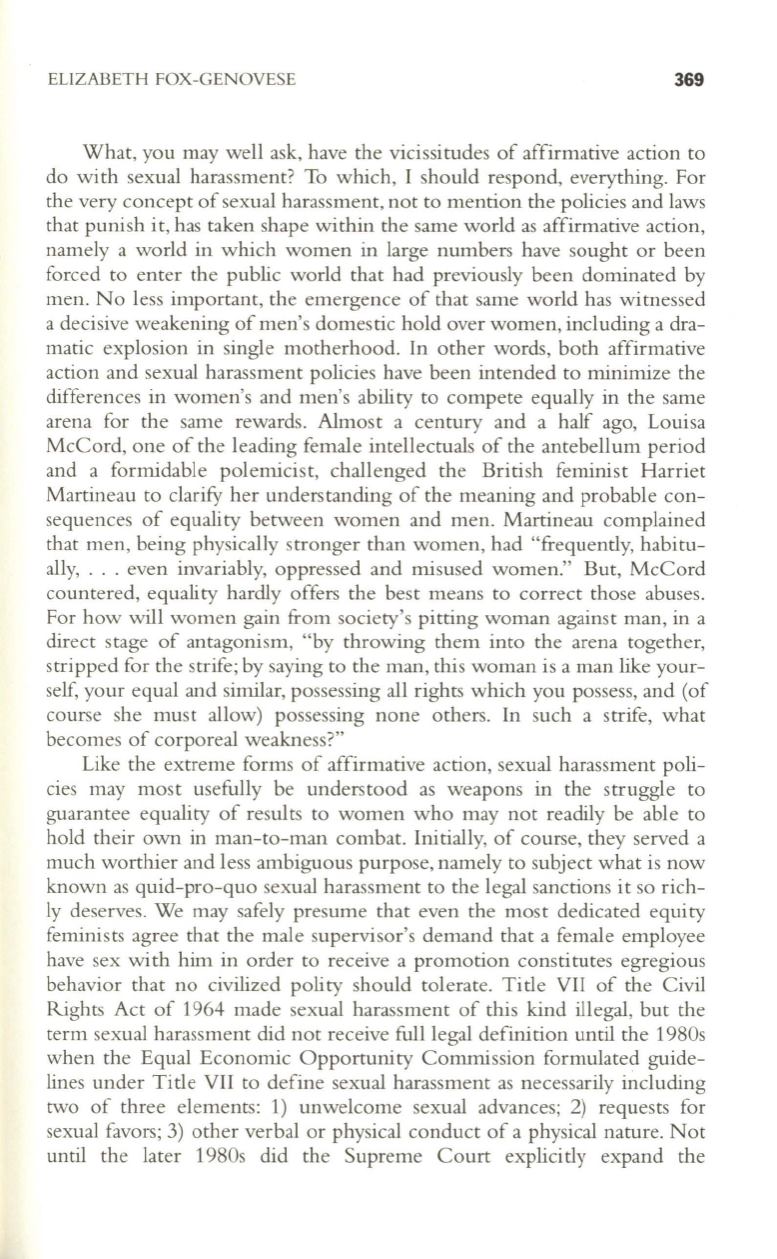
ELIZABETH FOX-GENOVESE
369
What, you may well ask, have the vicissitudes of affirmative action to
do with sexual harassment? To which, I should respond, everything. For
the very concept of sexual harassment, not to mention the policies and laws
that punish it, has taken shape within the same world as affirmative action,
namely a world in which women in large numbers have sought or been
forced to enter the public world that had previously been dominated by
men. No less important, the emergence of that same world has witnessed
a decisive weakening of men's domestic hold over women, including a dra–
matic explosion in single motherhood. In other words, both affirmative
action and sexual harassment policies have been intended to minimize the
differences in women's and men's ability to compete equally in the same
arena for the same rewards. Almost a century and a half ago, Louisa
McCord, one of the leading female intellectuals of the antebellum period
and a formidable polemicist, challenged the British feminist Harriet
Martineau to clarifY her understanding of the meaning and probable con–
sequences of equality between women and men. Martineau complained
that men, being physically stronger than women, had "frequently, habitu–
ally, ... even invariably, oppressed and misused women." But, McCord
countered, equality hardly offers the best means to correct those abuses.
For how will women gain from society's pitting woman against man, in a
direct stage of antagonism, "by throwing them into the arena together,
stripped for the strife; by saying to the man, this woman is a man like your–
self, your equal and similar, possessing all rights which you possess, and (of
course she must allow) possessing none others. In such a strife, what
becomes of corporeal weakness?"
Like the extreme forms of affirmative action, sexual harassment poli–
cies may most usefully be understood as weapons in the struggle to
guarantee equality of results to women who may not readily be able to
hold their own in man-to-man combat. Initially, of course, they served a
much worthier and less ambiguous purpose, namely to subject what is now
known as quid-pro-quo sexual harassment to the legal sanctions it so rich–
ly deserves. We may safely presume that even the most dedicated equity
feminists agree that the male supervisor's demand that a female employee
have sex with him in order to receive a promotion constitutes egregious
behavior that no civilized polity should tolerate. Title VII of the Civil
Rights Act of 1964 made sexual harassment of this kind illegal, but the
term sexual harassment did not receive full legal definition until the 1980s
when the Equal Economic Opportunity Commission formulated guide–
lines under Title VII to define sexual harassment as necessarily including
two of three elements: 1) unwelcome sexual advances; 2) requests for
sexual favors; 3) other verbal or physical conduct of a physical nature. Not
until the later 1980s did the Supreme Court explicitly expand the


